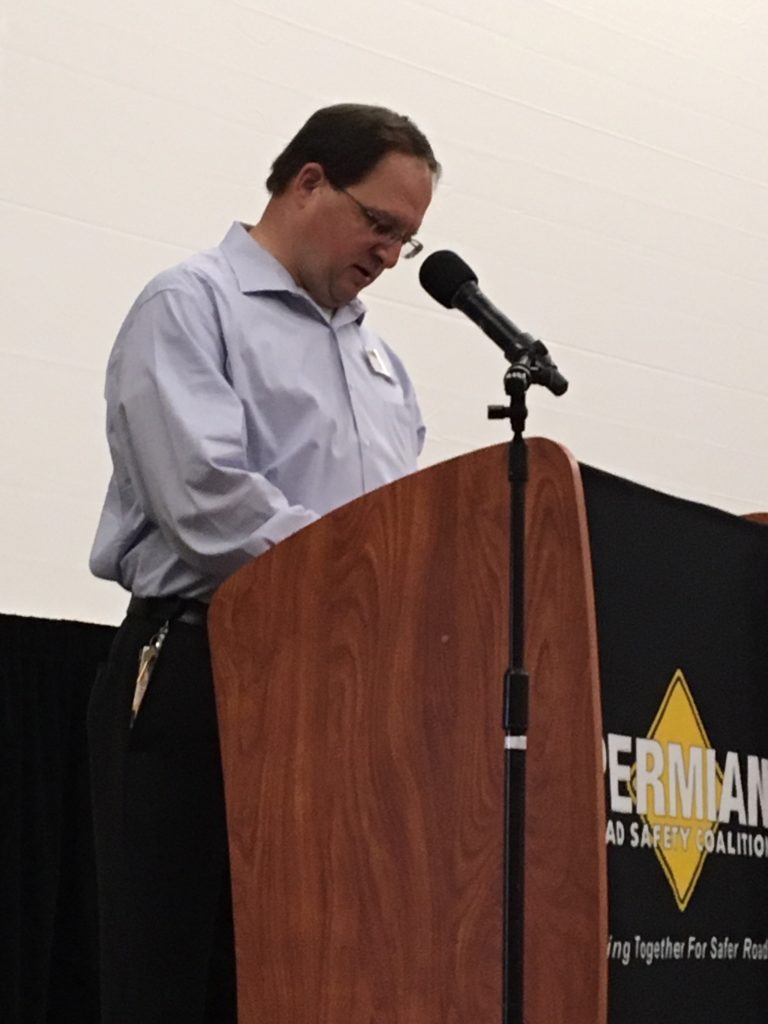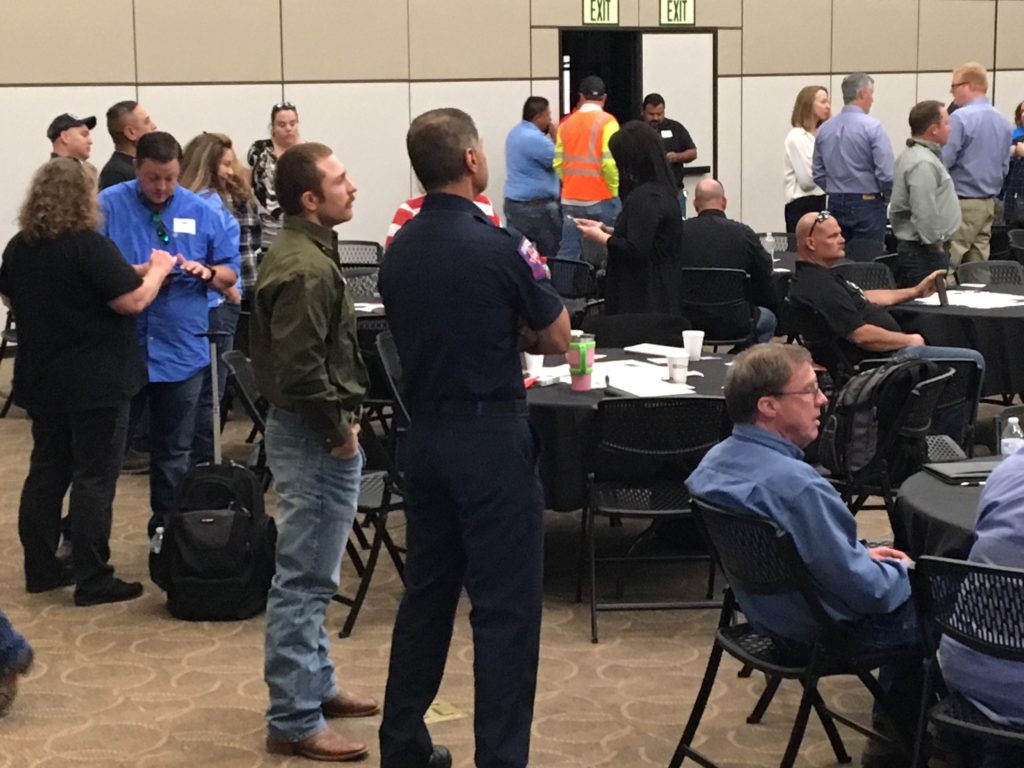By Paul Wiseman
There was a wreck on I-20 along my the way to a meeting about road safety. I’m not sure if that’s ironic or just appropriate. Just before I left Midland to head to the quarterly meeting of the recently-formed Permian Basin Road Safety Coalition, I received the following email from them:
“Traffic Delays To Today’s Meeting Reported. Please Take Alternate Route.”
Please be aware of an accident on I-20 between Odessa and Monahans blocking the westbound lanes. If you’re heading to the Permian Road Safety Coalition’s Q2 Forum please take an alternate route and take your time!”
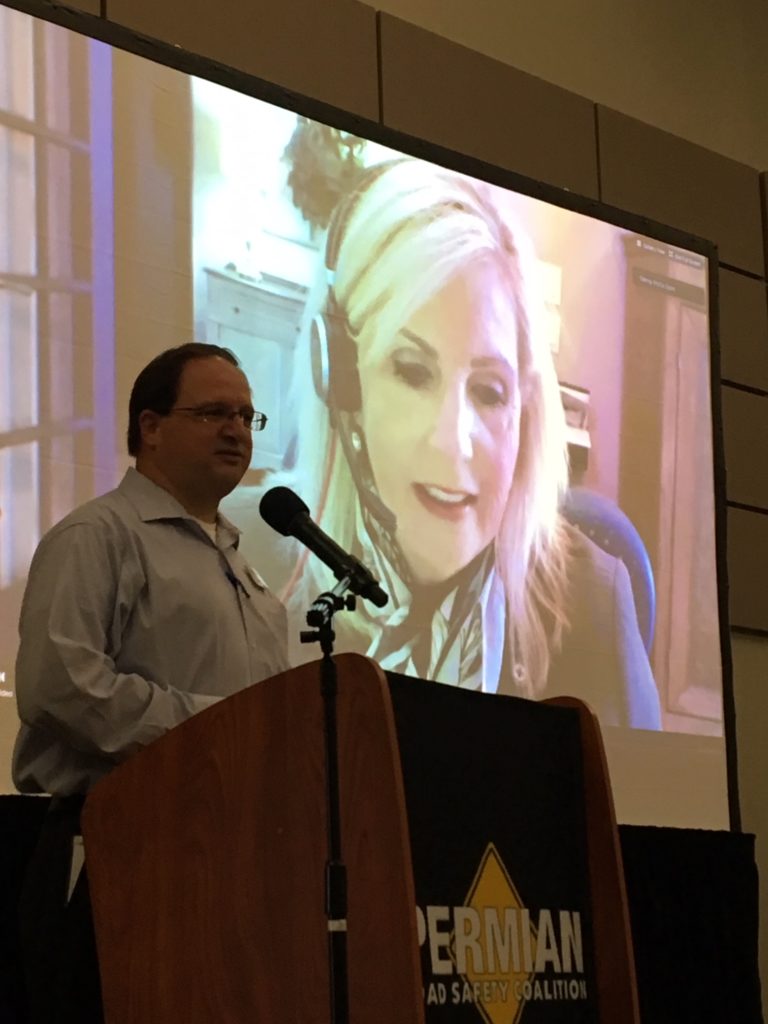
At the microphone is Scott Scheffler, the Executive Director of Permian Road Safety Coalition. He’s introducing Lisa Robinson, National Safety Council Senior Program Manager, whose video image is displayed on the screen beyond Scheffler. Robinson had to dial in instead of being there in person due to travel difficulties. She did a presentation on the dangers of drowsy and distracted driving.
The PBRSC began a couple of years ago, formed for the purpose of training and encouraging people in the area to drive more carefully and do all they can to avoid accidents. The entity became a fulltime nonprofit earlier this year. Shell has loaned Scott Scheffler to the coalition to be their Executive director. Scheffler is excited about the opportunity not only to spread the safety message but also to get the attention of TXDOT and other leaders in Austin to do what they can to improve roads. “Our goal for later this year is to make available safety training materials to the smaller mom-and-pop operations that don’t have the resources to train their employees themselves,” he said. “This will be sort of a ‘safety-culture-in-a-box.’”
Scheffler also hopes to wrest some highway money away from highway projects in more populated regions, with the biggest focus on U.S. 285 (Pecos to Carlsbad), SH 302 (either side of Kermit) and SH 18 (North and South of Kermit and Monahans).
By the way, between Odessa and Monahans, once you pass Odessa’s Loop 338 going west, there isn’t an “alternate route,” so I waited a while and cruised through after they’d cleaned up the wreckage. I really hope no one was injured.
But scenes like that happen daily along interstates, U.S. highways, and lease roads in the Permian Basin. The Texas part of the region hosts only two percent of that state’s population, but is the scene of 11 percent of Texas’ highway fatalities. In 2018 there were 291 fatal accidents in the 22 counties that comprise the Permian Basin, including Lea and Eddy counties in New Mexico. That’s up considerably from the 2017 count of 229. The stretch of U.S. 285 between Pecos and Carlsbad, N.M., is one of the deadliest in the entire nation—and only a few dozen people get their mail along that route.
Even the chairman of the Texas Department of Transportation (TxDOT) didn’t know how busy our roads were until he visited in May, at the request of the Permian Strategic Partnership. The PSP is a coalition of area producers and service companies who have banded together to collect and contribute millions of dollars to expanding infrastructure, including roads, schools, and other resources. Former Commerce Secretary Don Evans is the chairman.
TxDOT chairman Bruce Bugg told attendees at a May 22 luncheon in Midland that his visit gave him a much clearer picture of the Basin’s traffic issues than the traffic numbers had indicated.
For those of us who drive the region every day, our only surprise is when we arrive at our destination without a near-miss or without passing a crash scene.
That’s the case for conference attendee Armando Ortega, sales development manager for Mulholland Energy Services in Pecos. “Our goal here is to put out the word for the public about driver awareness. We preach it and practice it every day at work, but trying to get that information out to the community is our top priority right now.” He added, “We learn a lot from these meetings.”
As one who was involved with this coalition from the start, Ortega has seen attendance grow significantly over the last 12 months. Maybe the word is indeed getting out.
Coworker Nicholas Gallegos, Mulholland’s HSE and security director, said the meetings encourage him by showing that “we’re not the only ones out there” emphasizing safety. “If you live here, you have family on the roads, too. I have a wife and two kids that I think about every day that I send my drivers out on the roads. We remind our drivers of that every day.”
Gallegos sees where the influx of people echoes history. “I guess you could look at it as this is a modern day gold rush—everybody’s rushing here for the modern day gold rush.”
The keynote at the conference was delivered by Lisa Robinson, CFLE, a senior program manager for the National Safety Council. She addressed the meeting by teleconference from her home in Oklahoma due to storms in Dallas that cancelled her flight. Some of her main points included:
Losing 2 hours of sleep is equal to drinking 3 beers
Almost half (43 percent) of Americans sleep less than 7 hours per night (7-9 hours is recommended)
Driving with less than 4 hours of sleep makes a driver 4-to-5 times more likely to have a crash
Drowsy driving contributes to as much as 40 percent of highway crashes
She encouraged companies to contain driving hours to acceptable limits and to train and remind drivers that whether they’re on the job or traveling between home and work that safety is vital—and that it is the job of everyone.
The “gold rush” challenges are felt everywhere in the Basin. Schools in Odessa and Midland are struggling to keep up—in the 2015-2016 school year ECISD and MISD opened three new elementary schools each, but as of January 2019 ECISD lacked 230 teachers (400 positions overall were open) and MISD had 100 teacher vacancies, according to the Odessa American.
Evenings find many restaurants in both towns either closed or limited to drive-through service due to staffing challenges. Midland Memorial Hospital has had to funnel some emergency cases to Odessa’s Medical Center Hospital due to overcrowding. Crews from ONCOR, the local powerline provider, can be seen installing longer or bigger powerlines somewhere town almost every day. Homebuilders—themselves short on crews—can’t build houses or apartments fast enough. Construction-restricted lanes on a main road are forcing hundreds of cars per day down my own residential street. For-sale housing inventory is at a 1.77 month supply, with a six-month supply considered a balanced market, according to figures released by the Midland Board of Realtors in mid-May.
So, what’s the good news? It’s the other side of the same coin. All those people are rushing in because unemployment hovers around 2.1 percent in Midland (March 2019 numbers) and in Odessa it’s almost as good, at 2.6 percent (also March 2019). This is compared to a national unemployment rate of 4.0 percent and an overall Texas rate of 3.8 percent. Both cities are collecting record amounts of sales tax, and property valuations are rising by double digit percentages as the rush to buy limited housing fuels price and rent increases.
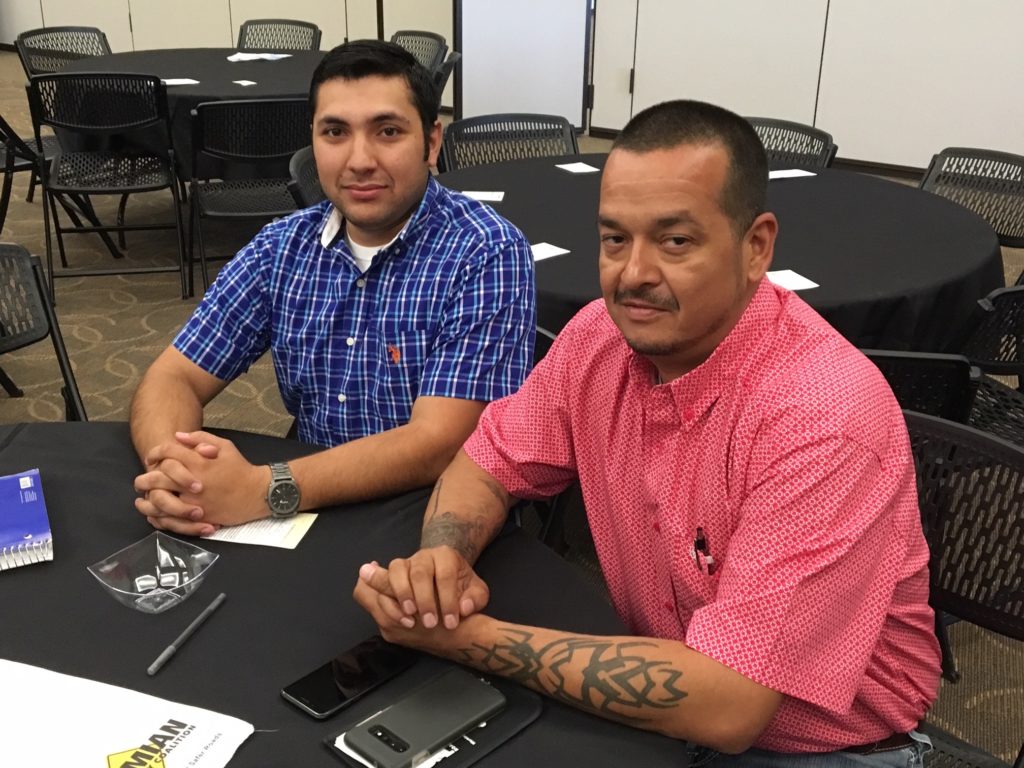
At left is Nicholas Gallegos, HSE and Security for Muholland Energy Services in Pecos, Texas. On the right is Armando Ortega, Sales Development Manager, also for Mulholland.
The previously-mentioned Permian Strategic Partnership is made up of 20 area companies, including such heavyweights as Anadarko, Apache, Chevron, Cimarex, ConocoPhillips, Encana, Schlumberger, Halliburton, Plains All America, Shell, and others. Their stated goal is to collect $100 million to put toward schools, health care, housing, transportation, and other infrastructure needs in the Basin. Formed in 2018, the Partnership is now in the early stages of gathering information from the community and amassing its war chest. While $100 million is appreciated and sounds like a lot, I imagine there will be enough requests to spend it several times over.
I’m guessing that the road challenges are not just from the population boom, but also are caused by what that population is doing. In most cities, a large contingent of people are only on the roads driving to work in the morning and driving home at night, with an occasional midday trip for lunch or to the dentist.
In the Permian, truck drivers (of whom the Basin is short about 7,000) spend all day and most of the night hauling frac sand, produced or fresh water, oil, diesel for onsite generators, and more across hundreds of miles of wide-open spaces. Another large contingent travels to and from well sites to move dirt for drill pads or frac ponds, scout for water sources, repair pumps, move drilling rigs and more. Some do sit in offices, but even they generally make regular trips to sites 100-200 miles away. That is a lot of road time.
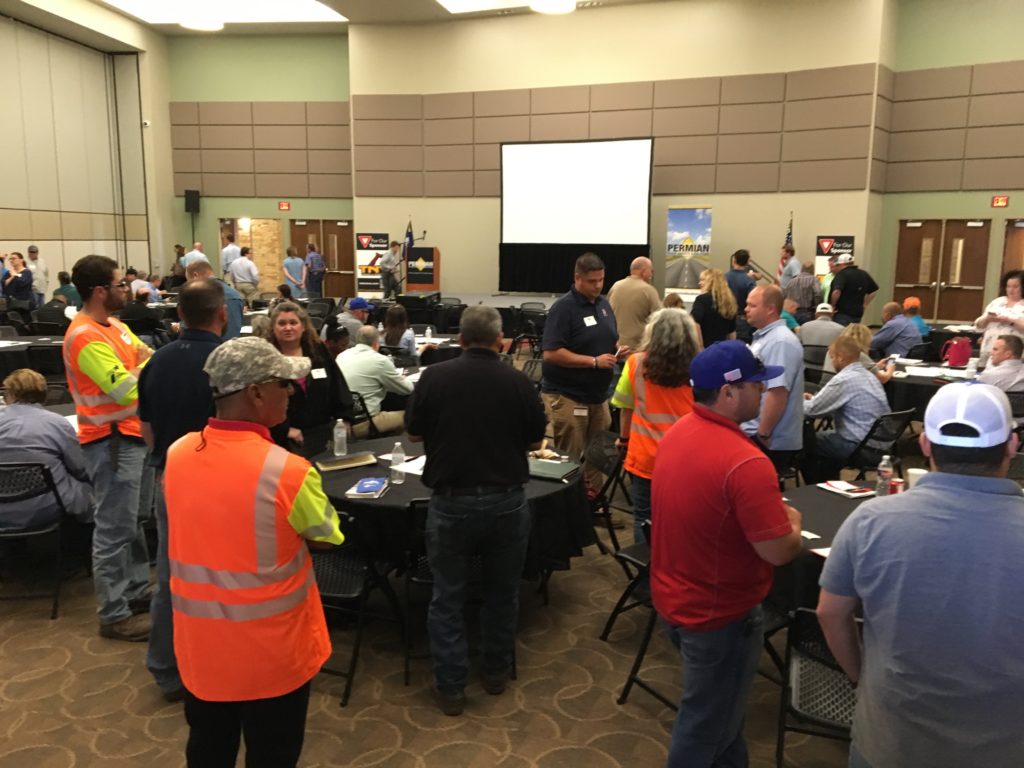
Attendees at the event had to deal with delays en route because of—surprise?—a wreck on Interstate Highway 20, which was either ironic or somehow apropos.
All this reminds me of something. In 1914 poet and historian Carl Sandburg wrote the following about Chicago:
Hog Butcher for the World,
Tool Maker, Stacker of Wheat,
Player with Railroads and the Nation’s Freight Handler;
Stormy, husky, brawling,
City of the Big Shoulders
With a few changes, from “Hog Butcher” to “Energy Provider” and “Player with Railroads” to “Digger of Pipelines,” that could apply to any city in the Permian—especially the part about the Big Shoulders.
A manager for a Black Mountain Sand mine in the Permian tells his employees every day that only one percent of all people in the world work in mines, but they’re providing services to the entire other 99 percent. That certainly applies to those who are “mining” oil and gas.
So, what’s happening here is vital to the economy of the nation and the world. That’s Big Shoulders indeed.
Living here is tough work, but somebody’s got to do it.
A whole lot of somebodies.
Paul Wiseman is a freelance writer in Midland.
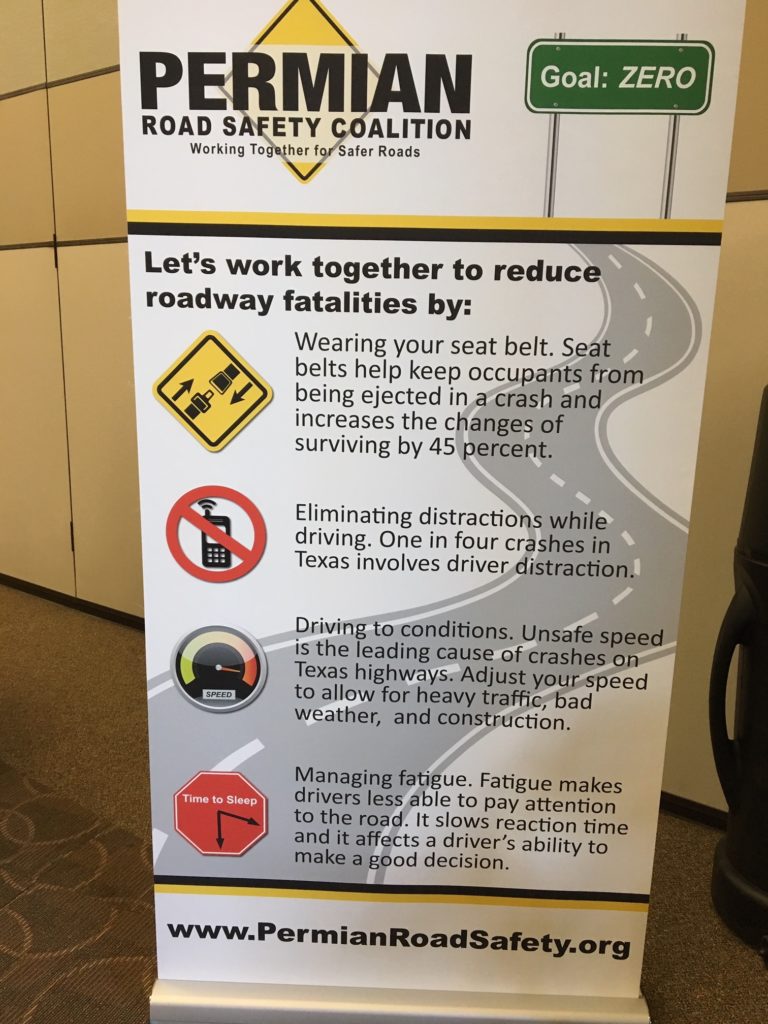
This poster greeted attendees at the most recent quarterly meeting of the recently-formed Permian Basin Road Safety Coalition.










